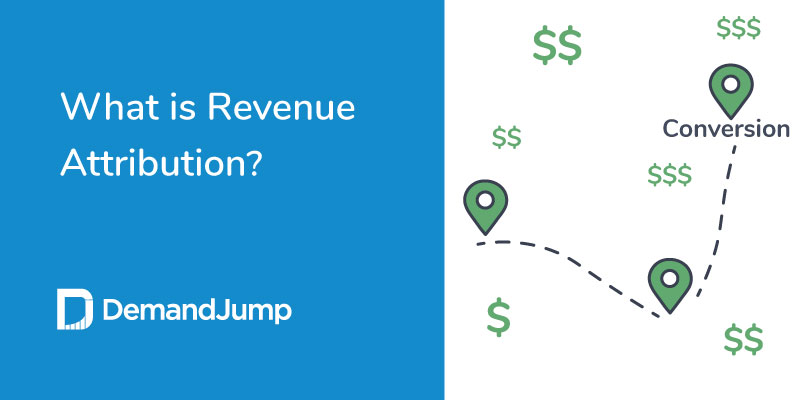What is Revenue Attribution?
March 10, 2021 •DJ Team

Revenue attribution, also called marketing attribution, is an important form of data collection that marketers utilize to gain key insights about how the individual components of their multimedia marketing campaign influenced or contributed to a resulting conversion or goal.
Today’s marketer is experiencing growing demands and responsibilities to drive revenue while analyzing performance and implementing changes to their marketing campaigns to improve return on investments and increase effectiveness of all marketing tactics to drive more qualified leads and conversions.
Revenue attribution enables those marketers to capture and analyze that data easily and effectively.
Why is revenue attribution important?
Marketing professionals aiming to gather a clear-cut overview of their strategies and how they play a role in customer engagement need to understand and implement revenue attribution data capturing. Effective marketing, for your own brand or those you create for client brands, need to have numbers that support decisions made, now and in the future.
When you can understand how each channel or exposure was received by your target audiences, you can make estimated decisions that can improve your next campaigns, allowing you to drive a higher ROI while also capturing more leads and purchases.
Wondering which attribution model to use?
There are a number of strategies for scoring digital marketing tactics, and those attribution models can span across a few levels of touchpoint collection and attribution, but there are three main model types: single touch, multi-touch, and custom or data-driven attribution.
We’re constantly seeing new and exciting ways to give credit and gain insight into tactic performance, each level has their own popular methods. Let’s take a look.
Single touch attribution models
First click
Attributing credit to the very first piece of content that a user who ultimately converted against the goal of a campaign. This is often used to gather key data points for the performance of content within the awareness stage of a user’s journey with your online, multimedia content
Last click
Flipping first click methodology on its head, last click attribution methods focus on assigning credit based on the very last touchpoint a user interacts with before completing a conversion. Marketers use this method to score the performance of content that directly impacts a goal. Last click attribution methods are typically the default setting within many data collection tools because it requires little configuration while still providing very real attribution data points that made direct impacts on your target audience.
Multi-touch attribution models
Linear
Any and all touchpoints within a channel that ultimately led to a conversion are tracked through linear models. While this model will qualify any and all exposures that a user saw or interacted with prior to converting, it often limits datasets by not describing the weighted contributions of each individual component of the larger campaign.
Weighted
Weighted multi-touch attribution models allow digital marketers to craft their own logic behind how they attribute credit to their marketing efforts. Due to the nature of weighted attribution models, they tend to require more heavy lifting on the marketer’s side of things. This typically involves discerning how your brand’s business goals are best affected by your marketing campaigns. If you have a multi-tiered journey that you intend to walk a user through, then you’ll want to determine how each stage of the journey is paired up with content and how that content works to better move users along.
Time Decay
Not every touchpoint will be important for capturing a conversion. For lengthy campaigns, some marketers choose to add a time-decay element to their determining factors on how they attribute credit. If a business wants to understand why a consumer moved fast through a set of touchpoints, they may choose to ignore earlier exposures if a certain amount of time has passed. This allows marketers to give a layered attribution accreditation scheme to ensure that older, forgotten exposures aren’t given a disproportionate amount of credit for their involvement in a conversion.
Data-Driven Attribution models, or custom attribution models
Many tools empower brands to create attribution models that are unique to their business, marketing channels, and goals. You may have read about Google Ads’ Data-driven attribution
Single-touch and even basic multi-touch attribution models capture simple data points that marketers use to gain a general sense of performance of their campaigns. Based on a campaign-specific set of criteria, data driven attribution models use algorithms to determine when and how much credit should be attributed to a singular touchpoint.

Gain unique and important metrics on your campaign performance
DemandJump’s Marketing Attribution solution can take your unique business goals, marketing channels, and audience into account to build custom credit attribution strategies. Ready to gain in-depth metrics on how every single component of your multimedia marketing campaigns? Sign up for a demo today!
Featured Articles
Categories
- Attribution Tracking (13)
- Channel Optimization (11)
- Consumer Insights (68)
- Content Marketing (251)
- Data Science (8)
- Digital Marketing (6)
- Digital Transformation (26)
- Enterprise (10)
- Lead Generation (14)
- Market Intelligence (8)
- Marketing Analytics (39)
- Marketing Attribution (57)
- Marketing Management (153)
- Marketing Operations (86)
- Organic Search (222)
- Paid Search (52)
- Pillar-Based Marketing (63)
- Programmatic Advertising (9)
- SaaS Content (14)
- SaaS Marketing (29)
- Search Marketing (111)
- SEO Keyword Research (28)
- SEO Pillar (18)
- SEO Strategy (46)
- SMB (5)
- Website Content (12)

